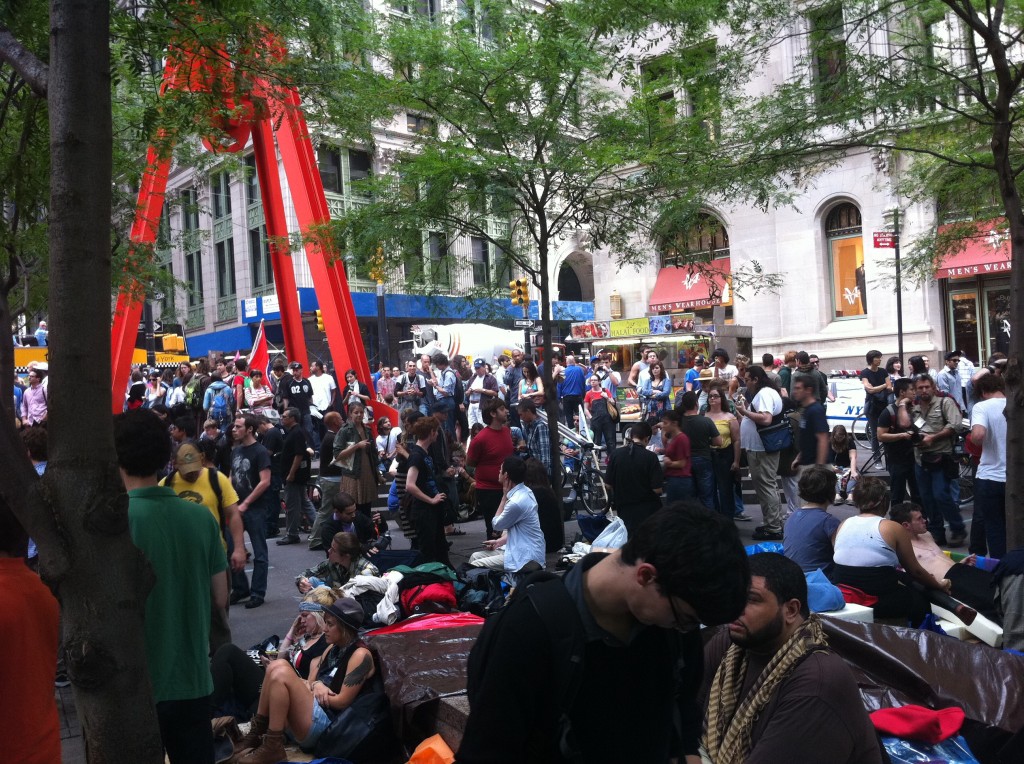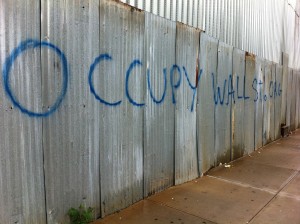
Last week I went down to Zuccotti Park out of an overwhelming desire to be a part of something intensely important. One of my professors compared the occupation of Wall Street to People’s Park in Berkley, California. He also sees strong connections to the ongoing hacktivist activities in Spain. OccupyWallst.org draws their tactics explicitly form the Arab Spring. I have waited so long to write something about my own experiences because, frankly, it almost feels too personal. So, if you’ll indulge me, this post is going to be a little different from the ones I’ve written in the past.
While the major news outlets try desperately to shoehorn OWS into existing frames, smaller outlets have provided excellent commentary and insight. Jenny Davis was the first on this blog to write about the movement’s use of social media. Since her insightful post, social media has proven to be an effective tool in revealing police brutality and even possible entrapment by the NYPD. The various Twitter backchannels have been instrumental in organizing and publicizing the organization – as well as the results- of major protests. Nathan has also done an excellent job of discussing the relationship of online and offline action. And yesterday’s post by Sarah Wanenchak describes exactly my feelings on the confluence of various forms of technology. There truly is no easy way to describe the feeling you get when you hear the people’s mic for the first time. It is a little difficult to master, but a truly powerful tool.
Having participated in everything from sweeping Zuccotti Park, to handing out the “Occupied Wall Street Journal,” to helping start a local occupation there is a pervasive sense of togetherness. Friend requests on Facebook explode, you learn the depths of blogging software, you loose your voice from screaming, but you talk through it because you are having a meaningful conversation with a total stranger on 125th Street. Over a decade ago, when Robert Putnam was writing Bowling Alone he bemoaned the generational loss of social capital. At the time, he saw little promise in the message boards and chat rooms of the dial-up internet. Nothing could replace face-to-face communication. And he was almost right. Putnam says,
Above all, then, as now, older strands of social connection were being abraded-even destroyed-by technological and economic and social change. Serious observers understood that the path from the past could not be retraced, but few saw clearly the path to a better future.

Voluntary associations in the mid 20th century provided deep social relationships, but they were bounded into silos of different races, classes, and genders. As those classifications have been challenged, abandoned, or radically transformed, our social environment evolves faster than we can change ourselves. We feel a vague sense of disconnectedness as we search for new and meaningful voluntary associations. New associations are coming from unexpected places, and offer multiple entries into new kinds of voluntary associations. Our twitter feeds and Facebook networks allow us to reach across geographic boundaries and relate to one another through political affinities, niche hobbies, or even vaguely defined -but powerful- movements. Our associations begin to take on a rhizomatic shape. They spread horizontally and offer multiple entry points but maintain their cohesiveness as an identified whole. Through our augmented voluntary associations we are beginning to see a rhizomatic re-construction of voluntary associations.
A lot of ink has been spilled over whether our digital connections pull us together into a global community or push us apart into our own highly specialized tribes. I do not find either to be very convincing- as they mostly fall into the trap of digital dualism. I would rather point to the wide-spread solidarity created by and through the Occupy Wall Street movement and show that as long as the bits keep flowing, we will have the ability to create new kinds of voluntary associations. These new augmented voluntary associations are rhizomatic, that is, they run horizontal instead of vertical, provide multiple points of entry, can mobilize large groups into collective action, or pit them against one-another in partisan confrontation. Whatever the outcome of the Occupation movements, it is important that we recognize the power of these new associational patterns and use them in the most inclusive and productive way possible.

Comments 7
cyborgology + #ows | Full-Stop.net — October 25, 2011
[...] -#OWS and the Formation of Rhizomatic Associations by David Banks [...]
Stephen Stollmack — November 24, 2011
And what has this to do "with the price of tea in China"? I can't see what the cyber-relationships between shifting matrixes of twitterers has to do with the development of the required movement for Social Change in this country. Cyber connections got people out in the street in Egypt and Libya but the issue(s) were clearer – there were dictators who needed to be deposed! We all know that a revolution is not going to work in a two-party system (like ours) where the issues we raise will just be used by one party to unseat the other and things will go on as ever before. Maybe you twitterers can get people out in the streets when the time is right but "right" for what. I wouldn’t trust the average American with a musket if I were handing them out. He/she is not educated to understand the issues and definitely not trained to handle public responsibility. So, all this cyber chatter seems to be simply headed for the Tower of Babble, as far as I can see.
So, with all this discussion, how come we have not seen OWS condemn our education system for producing the Corporate leaders, Lobbyists and corrupt Bankers who tanled our economy? The boys that are allowed to cheat and bully and intimidate others not only go on to be the bandit-banker execs but many become sexists, womanizers, gay-bashers and racists. So, where are the alliances between OWS and Feminist organizations and organizations that seek to level economic playing fields between men and women; between blacks and whites; and so on? Why aren’t we seeing OWS or OP or OSF filing law suits against the Education Systems around the country in behalf of bullying victims or high school graduates who could not pass College entrance exams or get decent jobs? I suppose, we are not ready for such focused action but we are ready to twitter our time away supporting each other or supporting each other’s views of what is happening here and there around the globe. The poor can’t afford to spend hours on the internet; they are absorbed by their oppressive work schedules, by sickness and inadequate healthcare, and by the need to suffer the indignities of un- and under-employment. Our world and our economy can’t wait for building associations in the ether-cloud. We need to get change on the road now because it is going to take generations before we evolve our citizenry to the point where we can entrust them with the keys each others survival. Education is far behind in its understanding of children need to be brought up with a sense of social consciousness and its time that we need to give them a shove in the right direction.
Lets see some focused actions coming out of all these Occupy sites.
Self-Organization and The Hierarchy of Institutions » Cyborgology — December 31, 2011
[...] fight against the increasing expansion of Ellulian technique. The occupations are self-organizing, they are rhizomatic, and they do not rely on individual office-holders or positions. The #ows vocabulary has words for [...]
#OWS and the Formation of Rhizomatic Associations « Learning Change — February 7, 2012
[...] Ready Share:MoreShare on TumblrDiggEmail [...]
#OWS and the Formation of Rhizomatic Associations » Cyborgology | Adolescent Literacies | Scoop.it — February 9, 2012
[...] background-position: 50% 0px; background-color:#222222; background-repeat : no-repeat; } thesocietypages.org - Today, 11:45 [...]
#OWS and the Formation of Rhizomatic Associations » Cyborgology | Rhizomatic Learning | Scoop.it — February 9, 2012
[...] background-position: 50% 0px; background-color:#222222; background-repeat : no-repeat; } thesocietypages.org - Today, 11:48 [...]
The Myth of Virtual Currency » Cyborgology — November 22, 2013
[…] Currency itself does not hold inherent value. Even gold, as Marx observed, does not have some natural or inherent property that makes it equal in exchange value to the products of human labor. Bitcoins are attractive to some people because Bitcoins’ measurement of value cannot be altered by a central bank or government. In other words, Bitcoins aren’t subject to value manipulation (i.e. inflation) by obscure bureaucracies with their own private interests. What I think is overlooked here, is that escaping direct control of one bureaucracy (the Federal Reserve or the Chinese government) does not mean you have separated yourself entirely from that organization or from the influence of similar bureaucracies. The fetishization of the “virtual” aspect of Bitcoins goes a long way in obscuring the possibility that Bitcoins could be manipulated. The promise of Bitcoin’s stability is strengthened by our belief that the network is immune from old social structures; that a decentralized computer network determines an isomorphic social organization. […]